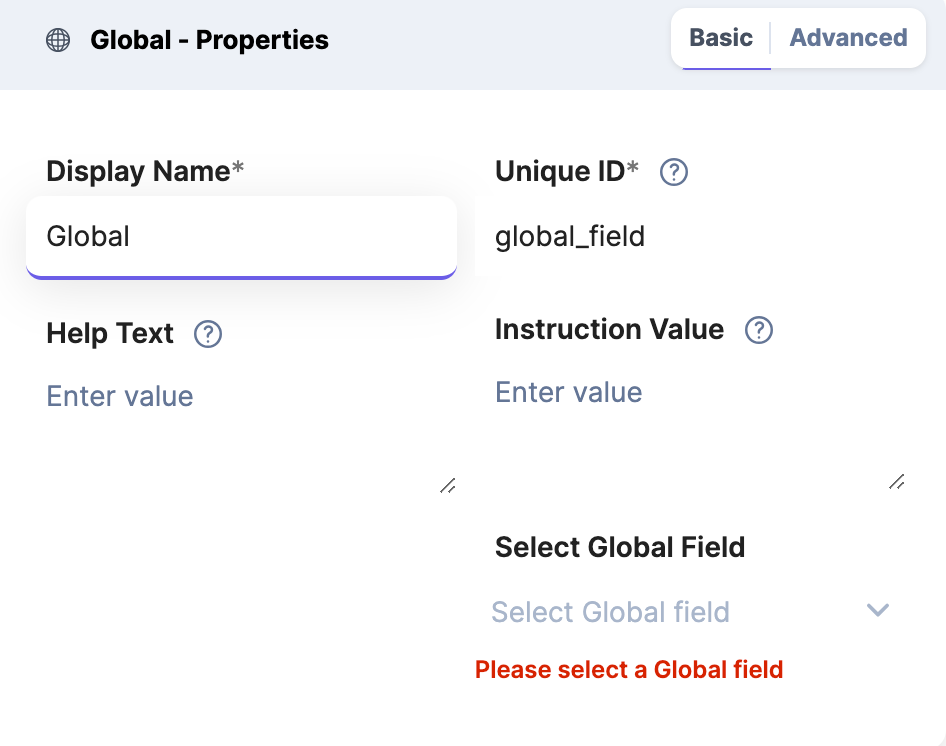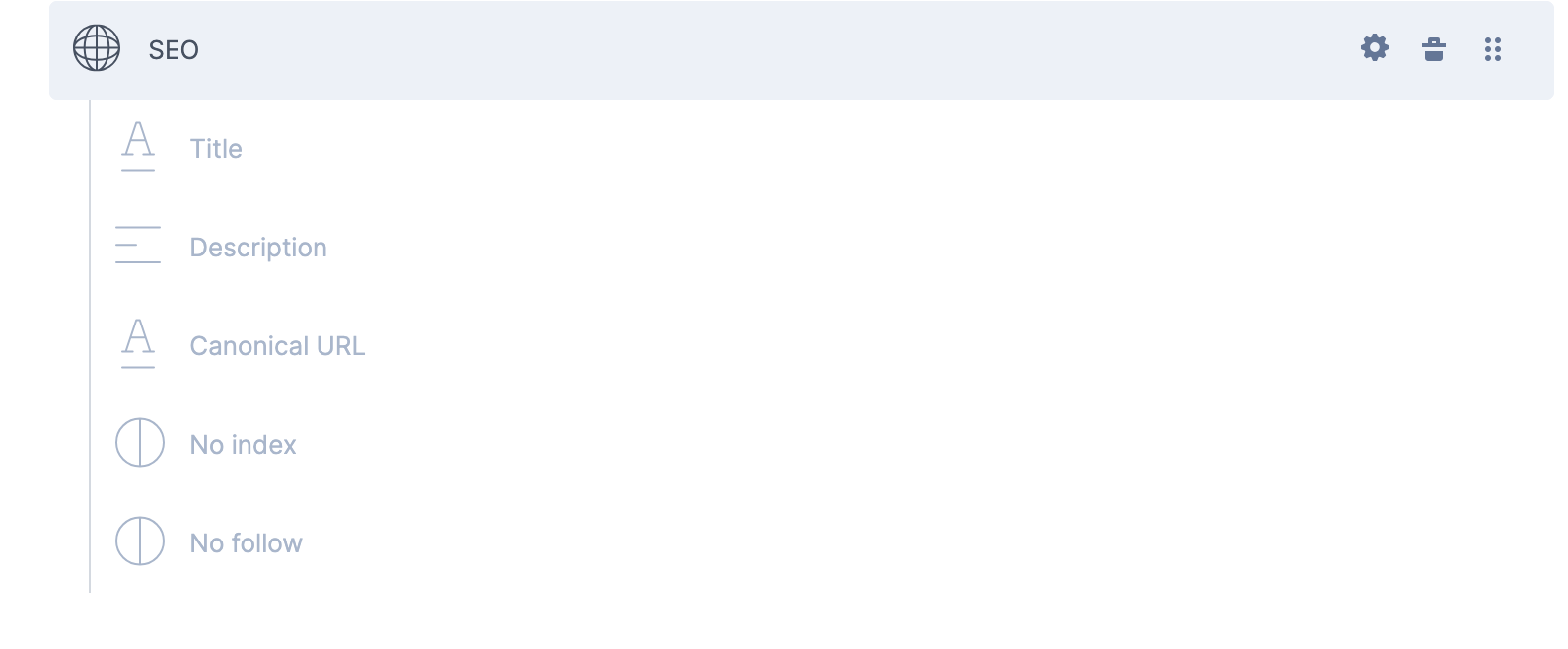Global Fields
Global fields are a feature that allows you to define and manage reusable content elements that remain consistent across your entire website or application. They are a way to create and store content that can be shared and reused across multiple pages or sections. Global fields can include components like headers, footers, navigation menus, banners, call-to-action banners, site-wide messaging, SEO metadata, or any other content element that appears consistently throughout your digital properties. By centralizing these elements, global fields ensure consistency, streamline content updates, and promote efficient collaboration.

In this lesson, we explore the power of Contentstack Global Fields, a feature that enables the creation and management of reusable content elements across websites and applications. Discover how Global Fields ensure consistent branding, streamline content updates, and optimize collaboration between teams. With time-saving automation, efficient workflows, and centralized content updates, Global Fields offer a robust solution for scaling content and delivering a cohesive user experience. Learn practical applications and best practices to leverage Global Fields effectively and overcome potential challenges, making content management a breeze.
Consistent Experiences with Global Fields
In this lesson, we explore the advantages of using Contentstack Global Fields. These benefits encompass streamlined content management, enhanced collaboration, and consistent user experiences across digital platforms. With time-saving automation, efficient workflows, and centralized content updates, Global Fields provides a powerful solution for scaling and personalizing content, making it easier for teams to deliver content swiftly and maintain a cohesive brand identity.

Let's look at some ways Global fields can assist:
Consistency: Global Fields ensures consistency by centralizing and reusing content elements, such as headers, footers, and navigational menus, across multiple pages or even different websites. This helps maintain a unified brand identity and user experience.
Time-Saving: Instead of updating content individually on every page, changes made to Global Fields are automatically reflected across all pages using them. This saves time and effort for content managers and ensures real-time updates.
Streamlined Updates: Content updates can be made in one place, the Global Field, reducing the risk of errors and inconsistencies that may occur when manually updating content in multiple locations.
Efficient Collaboration: Global Fields enable collaboration between different teams or departments. Content creators can focus on creating content within their expertise, while developers handle the implementation of Global Fields, resulting in a more efficient workflow.
Faster Time-to-Market: With Global Fields, content changes can be made rapidly, allowing for quick updates and releases. This helps in delivering new content and updates to the audience faster.
Content Governance: Global Fields allow administrators to set permissions and control access to specific fields. This ensures content governance, allowing only authorized users to modify critical content elements.
Localized Content Management: For multilingual websites, Global Fields help manage localized content effectively. Language-specific content can be managed through Global Fields, making it easier to maintain and update translations.
Reusability: Global Fields can be used across different content types and entries, offering more flexibility in content structuring and reuse. This helps in maintaining a standardized content architecture.
Scale and Flexibility: As your website or application grows, Global Fields provide the scalability and flexibility to adapt to changing requirements while keeping content management simple and organized.
Content Personalization: Global Fields can be used to implement dynamic and personalized content elements based on user preferences, behavior, or other data, improving the overall user experience.
API Access: Contentstack's Global Fields can be accessed via APIs, allowing developers to integrate them seamlessly with other systems or applications.
Overall, Contentstack Global Fields offer a powerful and user-friendly solution for streamlining content management, enhancing collaboration, and ensuring consistency and efficiency across digital properties.
Global Fields in Practical Use
Global Fields empower content managers to centralize and standardize content elements across websites, ensuring consistency in branding and user experiences. Discover how Global Fields streamline content management, optimize collaboration, and deliver efficient updates, saving time and effort in maintaining dynamic and personalized content across digital platforms.

Here are some general situations where you might use global fields:
Standardized Branding Elements: Use Global Fields to manage branding elements like logos, slogans, and brand colors across all pages and websites, ensuring a consistent brand identity.
Shared Navigation Menu: Implement a shared navigation menu using Global Fields, so any updates to the menu are automatically reflected throughout the entire website, saving time and effort in maintaining the navigation structure.
Footer Information: Utilize Global Fields to manage footer content, such as copyright information, contact details, and links to social media platforms, ensuring uniformity across all pages.
Call-to-Action (CTA) Buttons: Employ Global Fields to manage CTA buttons, allowing marketing teams to easily update and optimize CTAs for promotions or campaigns throughout the site.
Promotional Banners: Use Global Fields for managing promotional banners or pop-ups, enabling marketing teams to display time-sensitive offers or announcements consistently across the website.
Multilingual Support: Utilize Global Fields for localized content, managing translations of common content elements like headers, titles, and CTAs for different languages.
SEO Meta Tags: Implement Global Fields for SEO meta tags like title tags and meta descriptions, ensuring a standardized approach to search engine optimization across the website.
Content Reuse: Use Global Fields to store reusable content blocks like testimonials, FAQs, or company information, making it easy to update this content and display it across multiple pages.
Dynamic Content: Utilize Global Fields for dynamically generated content based on user behavior or preferences, such as personalized greetings or location-based information.
Special Offers or Announcements: Employ Global Fields to manage time-sensitive offers or announcements that need to be displayed consistently across various sections of the website.
Overall, Global Fields offer a versatile and efficient solution for managing content elements that need to be shared and consistently displayed across multiple pages or websites. They streamline content updates, reduce duplication efforts, and ensure a seamless user experience.
*Note: When creating a new content type, Global Fields have a unique approach. They're first established independently. Once set up, they can be referenced within content types or Modular Blocks
Global Fields: Understanding Challenges
While global fields can help centralize content elements and streamline management, it's essential to be aware of their challenges. We'll explore the issues such as complexity, limited flexibility, governance concerns, and performance impact, providing insights to navigate these potential pitfalls effectively.
Keep an eye out for these obstacles:
Overuse and Complexity: Using Global Fields extensively across different content types and entries can lead to an overly complex content structure, making it difficult to manage and maintain in the long run.
Limited Flexibility: Global Fields may not cater to every specific use case, which could limit the flexibility in content structuring and presentation, especially for highly customized websites.
Content Governance: When multiple teams have access to Global Fields, it may become challenging to maintain content governance and ensure consistency, potentially leading to conflicting updates or redundant fields.
Versioning and Rollbacks: Managing versions and rollbacks of Global Fields can be cumbersome, as changes made to them may impact multiple pages or entries, requiring careful monitoring and planning.
Dependency Issues: If the structure or content of a Global Field is changed, it may affect other components or pages that depend on it, requiring thorough testing and coordination during updates.
Performance Impact: Loading content from Global Fields may impact website performance, particularly if the structure contains complex data or if many requests are made to fetch different Global Fields.
Multilingual Considerations: Managing multilingual content with Global Fields might pose challenges, especially if different languages have unique content requirements or if translations need to be closely managed.
Learning Curve for Content Managers: Content managers may require training to effectively use Global Fields, especially if they are not familiar with the concept of centralizing content elements.
Limited Developer Control: In some cases, developers may find it challenging to customize the presentation of Global Fields due to limited control over their rendering and styling.
Data Synchronization: When using Global Fields across multiple environments or for continuous integration/deployment, ensuring data synchronization and consistency can be complex.
Despite these challenges, careful planning, clear communication, and a well-thought-out content strategy can help mitigate potential pitfalls and ensure a successful implementation of Contentstack Global Fields.
The Gold Standard: Global Fields Best Practices
When using Global Fields, it's important to follow best practices to maximize their benefits and ensure efficient content management.
Here are some key best practices:
Strategic Planning: Before implementing Global Fields, have a clear content strategy and identify which elements truly need centralization for consistency and reusability.
Limited Usage: Avoid overusing Global Fields. Limit their application to essential and widely used content elements to maintain simplicity and ease of management.
Consistent Naming Conventions: Establish consistent naming conventions for Global Fields to make them easily identifiable and prevent confusion among content managers.
Clear Documentation: Document the purpose, usage guidelines, and any restrictions for each Global Field to facilitate seamless collaboration among team members.
Collaboration and Communication: Foster communication between content managers and developers to ensure the efficient implementation and management of Global Fields.
Version Control: Implement version control to track changes made to Global Fields and enable rollbacks if necessary, especially in a collaborative environment.
Testing and Validation: Thoroughly test Global Fields in different scenarios and validate their impact on various pages to ensure proper functionality and consistency.
Training and Onboarding: Provide training and onboarding sessions for content managers to familiarize them with Global Fields' usage and benefits.
Multilingual Considerations: Plan for multilingual content and ensure Global Fields support translations and localization effectively.
Regular Review: Regularly review Global Fields usage and assess their effectiveness in streamlining content management, making adjustments as needed.
By following these best practices, you can leverage Global Fields effectively, enhancing content consistency, collaboration, and overall efficiency across your digital properties.
Walkthrough: Implementing Global Fields for a "Related Articles" Section in News ArticlesObjective: Learn how to use Contentstack's Global Fields to create a consistent "Related Articles" section across multiple news articles on a digital news platform.
Scenario: You're managing an online news portal. To enhance reader engagement and increase page views, you want to introduce a "Related Articles" section at the end of each article. This section will showcase links to other relevant articles, ensuring readers have a seamless flow of content.
Step 1: Understanding Global Fields
Dive into the documentation to grasp the concept of Global Fields. These fields allow you to create a reusable set of fields that can be integrated across multiple content types.
Step 2: Creating the Global Field
In Contentstack, head to the 'Global Fields' section.
Click on 'Create Global Field'.
Name it "Related Articles."
Step 3: Structuring the Global Field
Article Links: Add a 'Group' field and within it, add multiple 'Link' fields where you can link to other articles on the platform.
Article Thumbnails: For each link, add an 'Image' field where a thumbnail image of the related article can be uploaded.
Article Descriptions: Add a 'Text' field for a brief description or teaser for each related article.
Step 4: Implementing the Global Field in 'News Article'
Navigate to your existing "News Article" content type.
Integrate the "Related Articles" Global Field into the content type.
Step 5: Populating the Global Field
When creating or editing entries for your news articles, populate the "Related Articles" section by linking relevant articles, uploading thumbnails, and adding brief descriptions.
Step 6: Review and Publish
Preview a few news articles to ensure the "Related Articles" section appears consistently and is functional.
Once satisfied, publish your articles.
Conclusion: By the end of this lesson, you'll have implemented a consistent "Related Articles" section across your news articles using Contentstack's Global Fields. This strategy not only boosts reader engagement but also ensures a cohesive reading experience, guiding readers to more relevant content.
Module Summary: Weaving Cohesion with Global Fields
This module highlighted the immense benefits of Contentstack's Global Fields in streamlining content management. We explored their role in ensuring consistent branding, optimizing collaboration, and delivering a seamless user experience across websites and applications. By centralizing and reusing content elements, we simplified updates, saved time, and maintained a cohesive brand identity. The practical applications and best practices shared empowered us to harness the full potential of Global Fields, enabling efficient content scaling and delivery. Embracing these powerful features enhances efficiency, consistency, and collaboration, ultimately elevating the overall content management experience across diverse digital platforms.
Learn more:
Optional Exercise: Implementing a 'Promotional Offer' Global Field in the 'Product' Content Type on Contentstack
Objective: Learn how to use Contentstack's Global Fields to consistently display promotional offers across selected retail products in your online store.
Scenario: You're in charge of the content for an online store. To boost sales and attract more customers, you decide to introduce promotional offers on various products. This will be a consistent section across selected products, informing customers about special deals or discounts.
Step 1: Understanding Global Fields
Familiarize yourself with Contentstack's Global Fields. These fields allow you to create a reusable set of fields that can be integrated across multiple content types.
Step 2: Creating the 'Promotional Offer' Global Field
In Contentstack, navigate to the 'Global Fields' section.
Click on 'Create Global Field'.
Name it "Promotional Offer."
Step 3: Structuring the 'Promotional Offer' Global Field
Discount Percentage: Add a 'Number' field where you can specify the discount percentage (e.g., "10% off").
Offer Description: Include a 'Single Line Textbox' to provide a brief description of the offer (e.g., "Summer Sale!").
Validity: Add a 'Date' field to specify the start and end date of the promotional offer.
Terms and Conditions: Use a 'Rich Text Editor' to list any terms or conditions associated with the offer.
Step 4: Implementing the 'Promotional Offer' Global Field in 'Product Listing'
Navigate to your existing "Product Listing" content type in Contentstack.
Integrate the "Promotional Offer" Global Field into the content type.
Step 5: Populating the 'Promotional Offer' Global Field
When creating or editing entries for your products, populate the "Promotional Offer" section by adding the relevant offer details.
Step 6: Review and Publish
Preview a few product listings to ensure the "Promotional Offer" section appears clearly and is enticing.
Once satisfied, publish your product listings with the promotional offers.
Conclusion: By the end of this walkthrough, you'll have seamlessly integrated a "Promotional Offer" section across selected retail products using Contentstack's Global Fields. This strategy not only attracts customers but also provides them with clear information about ongoing deals, enhancing their shopping experience.
Next Up
Article
Custom Fields
8m 30s
